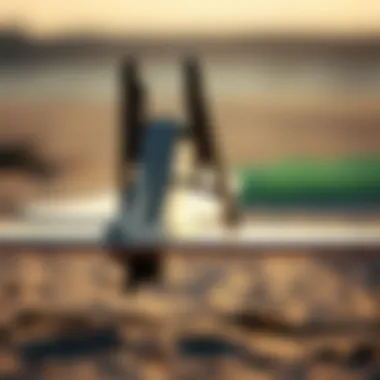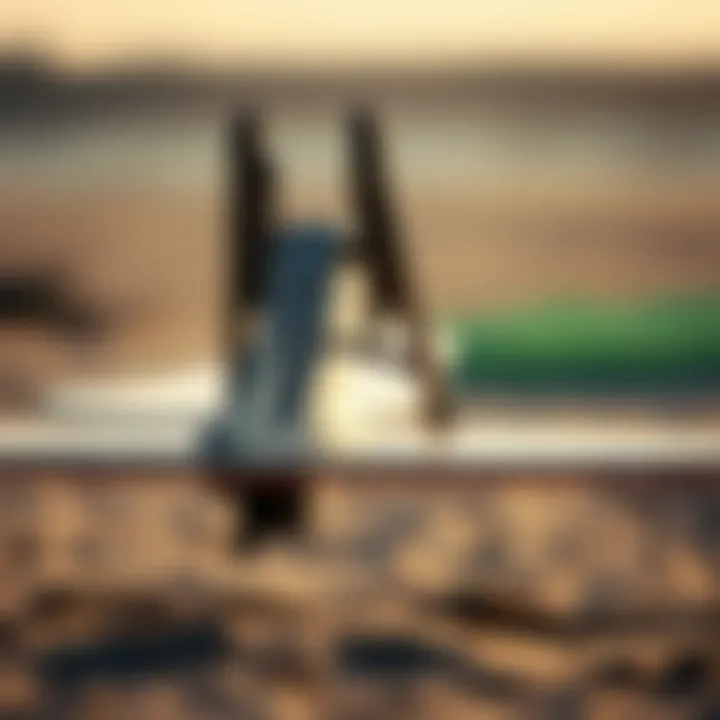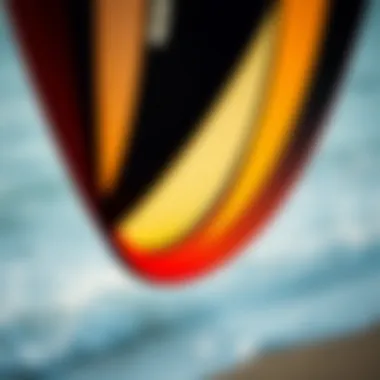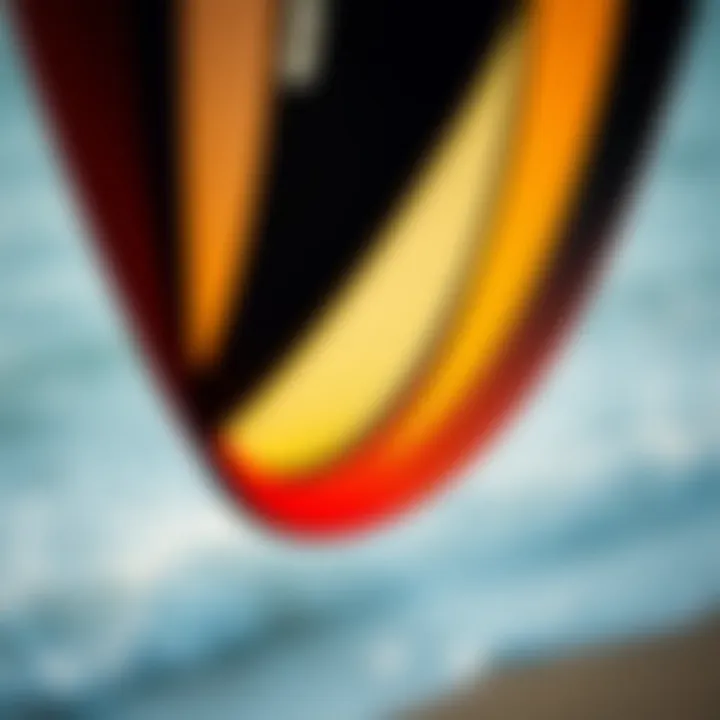Exploring the Key Elements of Kiteboarding Foils


Intro
Kiteboarding is not just about the thrill of gliding over water; it also involves a deep understanding of the equipment. At the heart of this sport is the foil, an integral component that significantly influences performance. A kiteboarding foil comprises various parts, each serving a specific function to enhance the rider's experience on the water. This article aims to peel back the layers of a foil's design, focusing on the interplay between its components and how they contribute to the overall effectiveness of the setup.
As we dive into the intricate features of these foils, discussions around materials, structure, and design principles will take center stage. Readers, whether they're just getting their feet wet or have been tearing through waves for years, will find the insights provided invaluable. Gaining a greater grasp of how a foil operates can dramatically influence not only performance but also enjoyment of the sport.
Equipment Insights
Understanding the components is essential for maximizing kiteboarding experiences. Each element of a foil—from the mast to the wings—plays a role in determining how well riders can catch the wind and ride the waves. Let's break down these components:
Mast
The mast is the vertical structure that connects the board to the foil’s wings beneath the water. It's typically made from lightweight materials like carbon fiber or aluminum, allowing for a good balance between strength and weight. The height of the mast affects the ride stability and how far the foil can dive below the surface.
Wings
Wings come in various shapes and sizes, serving different purposes. The front wing provides lift while the rear wing controls the pitch. Riders often choose their wing configurations based on conditions—larger wings allow for easy lift at slower speeds, ideal for beginners, while smaller wings are better suited for high speeds and advanced maneuvers.
Fuselage
This is the part that connects the front and rear wings, providing stability. Fuselage length can influence maneuverability. A longer fuselage often increases stability at high speeds, while a shorter one is easier to turn.
Board
Different boards complement various foil setups. They should be selected based on riding style and preferences. A board designed for foiling will typically be wider for added stability and buoyancy.
"Understanding what each component does helps riders make informed decisions about their gear choices and ultimately enhances their time spent on the water."
Select the Right Foil
- Performance: Match the foil to your skill level and riding style.
- Conditions: Consider local wind and water conditions when choosing a setup.
- Weight: Lighter foils tend to provide better performance but check for durability.
Technique Exploration
Once you have the right gear, fine-tuning your technique can lead to a more enjoyable kiteboarding experience. The way a rider engages with their foil plays a significant role in achieving a smooth ride.
Basic Techniques
For newcomers, understanding the basics of harnessing the power of wind with the foil is crucial. Practice balance and control to get a feel for how the foil lifts and glides. Spend time learning how to manage speed and direction by altering body position and weight distribution.
Advanced Maneuvers
As riders become more confident, they can start exploring advanced techniques, such as carving turns or catching air. Mastering these skills not only boosts performance but also enhances the overall joy of kiteboarding.
Prolusion to Foil Design
Foil design is vital to the world of kiteboarding, acting as the unsung hero that can make or break a session on the water. The basics of foil design stretch beyond just aesthetic shapes; they fundamentally form the interaction between the water and the air that allows kiteboarders to experience flight. Understanding how these elements come together helps riders make informed decisions about their gear, ultimately enhancing their performance in various conditions.
The design of a foil can significantly impact efficiency and stability. A well-crafted foil can allow a rider to glide effortlessly over the water, even on lighter winds, giving them a competitive edge in different environments. As kiteboarding evolves, so does the technology behind foils, meaning every new design introduces nuances that could benefit or hinder a rider’s experience.
In this section, we’ll delve into the intricacies of foil design, beginning with its evolutionary path, which reflects a progression in both performance and user experience.
The Evolution of Foils
The history of foils in kiteboarding is a tale of innovation and practicality. Originally, kiteboarding derived its dynamics from simple boards—the ones that wouldn’t turn heads at a craft fair but effectively skimmed the surface of the water. Early foils were rudimentary, designed primarily for basic lift rather than finesse or performance.
Fast forward a few years, and designers began to rethink the possibilities. They took cues from various aspects of aviation and maritime engineering. The introduction of gradual curves in unique shapes drastically changed how foils interacted with water. New materials came into play, like carbon fiber and specialized composites, that not only shaved off weight but bolstered resilience.


In today’s market, one can see foils designed for specific uses, whether it's for racing, freestyle, or all-around cruising. From hybrid designs that incorporate both stability and speed to those tailored for maneuverability, each variant represents a response to rider feedback and experimental design.
Importance of Foil in Kiteboarding
The foil plays a crucial role as the connective tissue between the kite and the board, enabling riders to carve through the air and skim across water surfaces with remarkable ease. Without a proper foil, kiteboarding wouldn’t maintain its exhilarating edge. This piece of equipment is engineered to convert the flying kite's pull into forward thrust effectively, allowing the rider to experience lift.
The intricacy of a foil's design influences critical performance factors:
- Lift: Influenced by the front wing and its shape, lift determines how high a rider can go in the air.
- Speed: Different shapes and materials directly affect how quickly a rider can glide across the water.
- Stability: Balance is essential; without it, a rider may face an unstable ride, especially in choppy conditions.
- Control: A responsive foil allows the rider to maneuver easily, executing turns and tricks.
Understanding these components and their importance not only aids new riders in making enlightened choices but also helps seasoned veterans experiment with designs that could enhance their preferred riding style.
Core Components of a Foil
To get the most out of kitboarding, understanding the core components of a foil is crucial. Each part plays a significant role in how the foil interacts with water and air. Loose or poorly performing parts can make the difference between a smooth ride and a frustrating outing. In this section, we will dissect the elements of a foil to reveal their individual contributions to performance and stability.
The Front Wing: Key to Lift
The front wing is bigger than just a piece of aluminum and plastic; it's the heart of the foil. This component is responsible for generating lift, which is why its design can make or break your ride. The shape and size of the front wing influence how the foil behaves in different conditions. For example, a larger wing might be beneficial for beginners or those trying to get up on the water, while smaller wings enable more advanced riders to perform tricks or speed through waves.
One must consider the angle of attack the front wing has against the water. A slightly tilted wing can increase lift but may also introduce drag. Thus, finding the right balance is essential. Riders often spend considerable time experimenting with different wings to understand which suits their style best.
"The front wing is not just a wing, it's your lift-off ticket."
The Back Wing: Balance and Stability
While the front wing is all about lift, the back wing plays a key role in maintaining balance and stability. This component is smaller than the front wing, but its importance cannot be overstated. By adjusting the size and angle of the back wing, riders can fine-tune how the foil responds to weight shifts and turns. This can be particularly important when conditions are choppy or during tight maneuvers.
A well-matched back wing can help in managing the pitch of the foil, allowing riders to keep control even in rough water. On the flip side, an ill-suited back wing can cause unwanted wobbling or make it harder to steer the kite effectively. The synergy between the front and back wings is critical for an enjoyable ride.
The Mast: Connection and Rigidity
Next up is the mast. It’s the rod that connects the wing assembly to the board. Its role is not just to keep everything in place; it must also be durable and rigid. A good mast looks to minimize flex while maximizing stability. When a mast bends too much, you lose control, leading to a frustrating experience.
Different materials can affect the performance of the mast. Carbon fiber, for instance, is both lightweight and strong, ideal for those looking to push the limits. On the other hand, aluminum is often heavier but can still perform well for casual riders. Length is another aspect to consider; longer masts allow for riding in deeper water, while shorter ones may provide more stability. A rider's choice in mast directly relates to their goals and skill level.
The Fuselage: Integration of Components
Last but not least, we have the fuselage. It essentially acts like the backbone of the foil, connecting the front and back wings as well as the mast. The fuselage needs to be built to last, with designs that promote efficiency and streamlined shape. Having a robust fuselage is essential for managing forces acting on the foil when it’s in motion.
Creating a stable connection between the components is essential for performance. Misalignment can lead to drag, which slows you down and affects your overall experience. In sum, the fuselage ties the entire foil together; it’s the unsung hero of kiteboarding gear.
Understanding these core components of a foil aids in better equipment selection and enhances the overall kiteboarding experience. Each rider must appreciate the delicacies involved in their equipment, as performing well on the water requires synergy among all these parts.
Material Considerations
When it comes to kiteboarding, particularly the foils that play such a vital role in enhancing performance, the choice of materials cannot be underestimated. Material considerations encompass not only the longevity and durability of the foil but also how these selections impact the rider’s experience on the water. Understanding these nuances can shape one's selection process, ensuring that both novice and experienced kiteboarders find the right balance of weight, strength, and flexibility in their gear.
Composite Materials in Foil Construction
Composite materials are often the unsung heroes of modern foil construction. These materials—often a blend of fiberglass, epoxy resins, and sometimes carbon fiber—strike a balance between weight and strength that raw materials simply cannot match.
- Lightweight: One of the primary benefits of composite materials is their lightness. This is crucial in kiteboarding, where reduced weight translates to increased responsiveness on the water. Lighter foils allow for sharper turns and greater agility, making for a more dynamic ride.
- Strength and Flexibility: The unique properties of composite materials offer incredible durability while still allowing for a degree of flex. This is important when riding in various conditions, as a foil that can absorb shock without cracking significantly improves the rider’s experience. After all, nobody enjoys a catastrophic wipeout due to gear failure.
- Cost-effective: While high-end materials like carbon fiber can be pricey, composites can be an economical choice without sacrificing too much in terms of performance. This makes them an attractive option for those new to the sport who might not want to dive headfirst into expensive equipment.
In essence, composite materials provide a well-rounded option for riders seeking durability without breaking the bank. It’s like choosing a dependable old truck over a sports car; the former gets you where you want to go but with lower risks of breaking down.
Aluminum vs. Carbon Fiber
The debate between aluminum and carbon fiber is akin to comparing apples to oranges—both have their merits, and ultimately, choosing one over the other often depends on personal preferences and specific riding conditions.


- Aluminum: This material is widely regarded for its strength and excellent buoyancy. Foils constructed from aluminum tend to be. more durable than their carbon counterparts under rough conditions. Additionally, they are typically more affordable, making them an excellent choice for entry-level kiteboarders. However, one must bear in mind that while they can withstand the wear and tear of rigorous use, they are heavier, which can affect overall performance.
- Carbon Fiber: On the flip side, carbon fiber offers a striking advantage when it comes to performance. It's ultralight and incredibly strong, allowing for faster speeds and easier maneuverability. Riders often find that their agility increases due to the reduced weight of the foil. Nevertheless, carbon fiber is considerably more expensive than aluminum. Hence, it’s generally favored by competitive riders or those who are quite serious about enhancing their riding performance.
In a sense, selecting between aluminum and carbon fiber is about matching the foil to your riding style and skill level. While some may prefer the rugged dependability of aluminum, others might find that the performance edge offered by carbon fiber justifies the additional cost.
For further insight into material sciences and the implications for sports gear, you might want to check out articles on Britannica or Wikipedia.
Organizations or forums like Reddit can also offer firsthand perspectives from fellow kiteboarding enthusiasts.
Aerodynamics of Foils
In kiteboarding, the aerodynamics of foils plays a crucial role in dictating overall performance and rider experience. Understanding how air interacts with the foil can make the difference between a lackluster ride and an exhilarating glide across the water. Benefits such as lift, speed, and control all stem from this fundamental aspect, making it paramount to grasp the underlying principles of lift and drag, as well as the effects of wing shape.
Understanding Lift and Drag
Lift and drag are the twin forces that every kiteboarder must reckon with when harnessing the power of the wind. Lift is the upward force that propels the rider into the air, while drag acts in opposition, resisting forward motion. The balance between these two forces can either float a rider gracefully above the water or slow down their progress, akin to a turtle on a lazy day.
To achieve optimal lift, several elements of the foil design are paramount:
- Angle of Attack: The angle at which the foil meets the water plays a substantial role. A greater angle increases lift but can also provoke more drag if too steep. Striking a balance is essential.
- Speed: More speed generally translates to more lift, up to a certain point. However, excess speed can lead to an unwelcome surge in drag, which can cause stability issues.
- Surface Area: A larger surface area increases lift but also amplifies drag. Riders must choose their foil size based on their experience and conditions.
Below are some general characteristics of lift and drag:
- Lift is generally measured in relation to the foil's speed and angle of attack.
- Drag increases as the speed of the foil rises or if the angle of attack is too sharp, forcing it to cut through the water less efficiently.
"The joy in kiteboarding comes from mastering the dance between lift and drag. It’s a constant negotiation and understanding that leads to a fulfilling ride."
Effects of Wing Shape on Performance
The shape of the wings on a foil can’t be overstated; it’s like the soul of the kiteboarding experience. Different wing shapes provide distinct advantages and characteristics, catering to various styles and skill levels. Flattened wings might offer more stability and are easier for beginners, while those with a sharper curvature can give advanced riders more speed and agility.
Here are some key factors influenced by wing shape:
- Aspect Ratio: A higher aspect ratio wing slices through water more efficiently, producing less drag and enabling increased speed. This is great for experienced riders chasing speed in choppy waters.
- Wing Area: Larger wings provide more lift but can slow down performance due to increased drag. Thus, they are often preferred by less advanced riders or in lighter wind conditions.
- Twin-Tip vs. Directional Wings: Twin-tip wings are usually more forgiving, while directional wings can offer improved performance in advanced moves but require more skill to effectively maneuver.
When it comes down to selecting foil components, the wing shape should reflect the rider’s style and the type of ride they seek. By considering these aerodynamic factors, a kiteboarder can dramatically influence their experience on the water, ensuring each ride is as exhilarating as the last.
Every rider has their personal preferences and experiences that tailor their understanding of aerodynamics. Some will find themselves turning the foil this way or that, trying new shapes when conditions change, but ultimately, it’s this knowledge that can enhance their journey into the wind.
Selecting the Right Foil for Your Needs
When it comes to kiteboarding, selecting the right foil is akin to finding the perfect partner for a dance. The interaction between rider and foil can significantly influence performance on the water. A poorly matched foil can disrupt balance, hinder lift, or lead to discomfort. Hence, understanding how to choose the right foil based on personal preferences and conditions is of utmost importance.
Factors Influencing Foil Choice
Choosing the right foil is not just about aesthetics; it's a complex decision influenced by various factors. Here are some critical elements to consider:
- Rider Weight: Heavier riders may require larger foils to generate enough lift, while lighter riders might benefit from smaller, more agile foils.
- Skill Level: Beginners often find larger foils more forgiving, offering better stability and lift at lower speeds. Advanced riders may prefer smaller foils for increased maneuverability, enabling quicker turns and higher jumps.
- Wind Conditions: The wind strength in your area plays a crucial role in foil selection. Strong winds might call for a smaller foil, while lighter winds typically need larger, more buoyant foils to stay on the surface.
- Water Conditions: Smooth water is more forgiving, but choppy or wavy conditions may require specific foil designs that can handle turbulence without losing control.
- Intended Use: Are you looking to race, freestyle, or just cruise? Each style has its own requirements that can influence which foil is suitable,
Ultimately, the right foil will align with your individual riding style, goals, and environmental conditions. It is wise to consult with experienced riders or local shops that specialize in kiteboarding to gauge better options.
Matching Foil Size to Rider Experience
Matching the foil size appropriately to your skill level can make all the difference. Here's a breakdown of how to approach this:
- Beginners: Generally, larger foils, such as those with wingspans ranging from 1200 to 2200 cm², provide greater stability and lift. Beginner riders might struggle with smaller foils that require precise control, making larger options a friendlier choice.
- Intermediate Riders: As skill progresses, an intermediate rider may venture into medium-sized foils, measuring between 800 to 1200 cm². These offer a balance of lift and control, allowing for a bit more performance without overwhelming the rider. Riding with these often helps develop essential skills like carving and jumping without feeling constantly on edge.
- Advanced Riders: Advanced riders may opt for smaller foils, usually between 600 to 800 cm². These designs allow for advanced maneuvers like aggressive turns and jumps but may require more skill to manage due to their sensitivity to changes in wind and water conditions.
"Choosing the right foil is about blending technology with rider capability. It’s essential to track improvements and adapt your gear as your skills grow."
Maintenance and Care of Foils


In the world of kiteboarding, having a well-maintained foil is essential for both performance and longevity. Just like a finely tuned instrument, your foil requires regular care to ensure it operates smoothly on the water. Neglect can lead to diminished performance and even safety issues, which can compromise the joy of ride. The two pillars of maintenance that every kiteboarder should focus on are cleaning and inspecting the foil components, along with adhering to proper storage practices.
Cleaning and Inspecting Components
When it comes to cleaning, simplicity is key. After every session, rinse your foil with fresh water to remove salt, sand, and debris. This simple act helps to prevent corrosion and degradation of materials over time. Using a gentle brush can assist in clearing off any particles that may have found their way into small crevices or along the wings.
"A regular check-up can save you from dealing with major repairs down the road."
It’s crucial to inspect components carefully each time you clean. Pay special attention to the front wing and back wing for any visible dings or scratches. Use your hands to feel for any abnormalities in the surface that may indicate wear and tear. Pay attention to screws and fittings as well; if they’re rusted or show signs of stripping, replace them immediately. A loose component can turn an exhilarating ride into a perilous dive.
Maintaining the mast and fuselage is equally important. Check for any signs of bending or fractures, especially after a rough landing. These parts are like the backbone of your foil setup, and keeping them in pristine shape ensures stability and performance on the water.
Storage Best Practices
How you store your foil can make a world of difference in its lifespan. Ideally, foils should be stored in a cool, dry place away from direct sunlight. Sunlight can degrade materials, especially the epoxy used on wings.
When packing your foil away, here are some key tips:
- Disassemble the Foil: Detach the wings from the mast and fuselage. This not only saves space, but also reduces the risk of damage from accidental bumps and falls.
- Use a Protective Bag: Invest in a padded or insulated bag for storage. This soft-touch precaution guards against unwanted impacts during transport and storage.
- Avoid Humidity: Storing your foil in a humid environment can promote mold or mildew, especially for any fabric components. Keep it in a room with a dehumidifier if you live in a particularly moist area.
- Keep it Out of Reach: If you have pets or small children, make sure your foil is stored high up or secured away. You don't want unexpected visitors to wreak havoc on your gear.
By reflecting on these cleaning and storage habits, kiteboarders can increase the longevity of their foils, ensuring they can carve through the water with the same precision season after season. Proper maintenance not only enhances performance but also nurtures a deeper connection to the sport and its engineering.
Future Innovations in Foil Design
The world of kiteboarding is not standing still; it’s like a wild river in constant flux, evolving with new innovations and designs. Future innovations in foil design are crucial for making the sport more accessible, enhancing performance, and addressing the environmental challenges associated with materials. To grasp the significance of these innovations, one must consider a few foundational elements—materials, efficiency, and rider experience. All these intertwine to create a foil that not only meets the demands of experienced kiteboarders but also welcomes newcomers.
Advancements in Materials Science
Innovation in materials science is akin to opening up new chapters in a book that never gets old. The next generations of foils will see the integration of newer, lighter materials that promise durability without compromising performance. For instance, advanced composites and blends of carbon fiber with eco-friendly resins are paving the way for foils that are not just lighter but also stronger. By fusing these elements, manufacturers can craft components that withstand the forces of nature while offering better performance on the water.
- Lighter Foils: The incorporation of new material technologies allows for lightweight designs that enhance maneuverability and speed.
- Eco-Conscious Choices: Innovations strive to reduce environmental impact. Biodegradable materials or those sourced sustainably are not just buzzwords anymore; they are becoming reality thanks to forward-thinking design.
- Enhanced Durability: New materials offer increased resistance to saltwater corrosion, a top concern for any kiteboarder.
Such advancements lead to an overall reduction in fatigue during rides, allowing for longer sessions without the physical toll often associated with heavier equipment. As kiteboarders, embracing these innovations means not only better performance but also contributing to the health of our oceans.
The Role of Technology in Design
When we think of technology in foil design, it’s easy to picture high-tech labs filled with screens and gadgets. However, it goes far deeper than that—technology is about understanding the nuances of physics and applying them to create high-performing equipment. Real-time data and AI are becoming invaluable in finetuning each aspect of foil design, and it's transforming how manufacturers approach development.
- 3D Modeling and Simulation: Cutting-edge software now allows engineers to simulate hydro-dynamic performance before any physical prototype is crafted. This approach saves time, resources, and often results in far superior designs.
- Sensor Technology: Some designs are even incorporating sensors, providing feedback on how a foil performs under various conditions. This could mean enhanced adjustments for stability and performance tailored to individual surfer needs.
- Customization: Riders can have foils designed according to personal specifications thanks to advancements in design technology. Manufacturers can adjust dimensions based on rider weight, skill level, or intended use.
As the kiteboarding community leans into these innovations, a more personalized and efficient riding experience becomes possible. Envision a future where every rider has access to tailored solutions that resonate with their unique style and conditions.
Remember, today's innovations pave the way for tomorrow's adventures in kiteboarding.
The synergy of advancements in materials and cutting-edge technology not only enhances performance but reshapes the narrative of what is possible in kiteboarding. As this field nudges forward, enthusiasts should remain informed and open to adapting, as the evolution of foil design is something that will undoubtedly touch every ride on the waves.
The End: The Integral Role of Foils in Kiteboarding
In the world of kiteboarding, the foil is not merely a component of the setup but a crucial factor that influences performance and overall experience on the water. Understanding the intricate details of foil design helps kiteboarders, whether they are beginners or seasoned veterans, to optimize their ride. The interplay between the various elements such as the wings, mast, and fuselage defines how a foil behaves under different conditions.
Reflection on Design and Performance
Reflecting on the role of design in foil performance illuminates a deeper appreciation for what kiteboarding offers. The geometry of the front and back wings, for instance, dictates how efficiently a rider can lift off the water and maintain flight. Small adjustments in design can lead to significant changes in lift and drag. Kiteboarders often find that a well-designed foil provides not just power but also a smoother ride, especially in choppy conditions. Moreover, material selection plays a vital role too; carbon fiber foils tend to be lighter and stiffer, which enhances responsiveness. This can make a difference when mastering complex maneuvers or simply gliding quietly over waves.
"Kiteboarding is like dancing with the wind; every component, every angle matters."
An effective foil design leads to an engaging experience, allowing riders to push their limits while ensuring stability and control. It’s this blend of engineering and rider skill that creates those unforgettable moments of soaring over the water. By diving into specific designs, enthusiasts can tailor their equipment to match personal preferences, ensuring every outing is both enjoyable and exhilarating.
Encouraging Exploration and Understanding
Encouraging further exploration into foil technology is essential for anyone involved in kiteboarding. Whether you are just starting or have some experience under your belt, knowing how to choose the right foil can make or break your time on the water. It isn't just about picking the shiniest or newest model; consideration should be given to various factors. You have to think about your own style, the conditions you typically ride in, and even your future progression plans.
Local forums, community meetups, and thorough online research can be invaluable resources. Engaging in discussions with fellow kiteboarders can unveil insights into what works in specific situations. Moreover, participating in testing events or demos can provide practical experience with different types of foils. Websites like Reddit often have threads where enthusiasts swap information and tips. The more knowledge you gather, the better decisions you can make.
In summary, the foil is a pivotal aspect of kiteboarding that warrants careful thought and appreciation. By learning more about their properties, along with staying updated on material advancements and design changes, you can enhance not just your performance, but also your connection with this exhilarating sport. The journey into the technical side of kiteboarding enriches the experience, opening up new horizons in your kiteboarding adventure.







